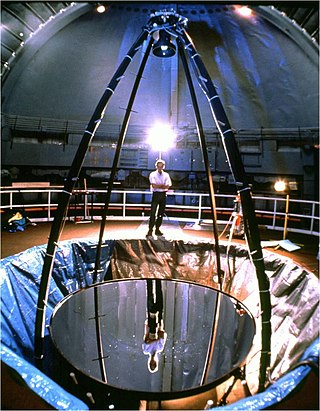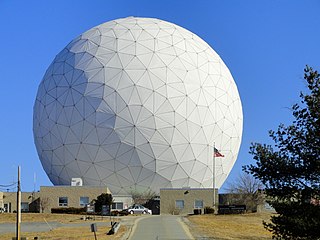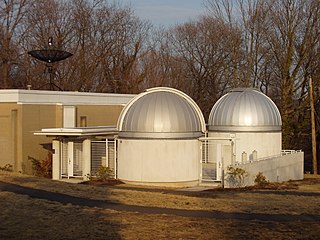
Gaithersburg is a city in Montgomery County, Maryland, United States. At the time of the 2020 census, Gaithersburg had a population of 69,657, making it the ninth-most populous community in the state. Gaithersburg is located to the northwest of Washington, D.C., and is considered a suburb and a primary city within the Washington metropolitan area. Gaithersburg was incorporated as a town in 1878 and as a city in 1968.

Lowell Observatory is an astronomical observatory in Flagstaff, Arizona, United States. Lowell Observatory was established in 1894, placing it among the oldest observatories in the United States, and was designated a National Historic Landmark in 1965. In 2011, the Observatory was named one of "The World's 100 Most Important Places" by Time Magazine. It was at the Lowell Observatory that the dwarf planet Pluto was discovered in 1930 by Clyde Tombaugh.

The International Latitude Service was created by the International Geodetic Association in 1899 to study variations in latitude caused by polar motion, precession, or "wobble" of the Earth's axis.

Onsala Space Observatory (OSO), the Swedish National Facility for Radio Astronomy, provides scientists with equipment to study the Earth and the rest of the Universe. The observatory operates two radio telescopes in Onsala, 45 km south of Gothenburg, and takes part in several international projects. Examples of activities:

The Allegheny Observatory is an American astronomical research institution, a part of the Department of Physics and Astronomy at the University of Pittsburgh. The facility is listed on the National Register of Historic Places and is designated as a Pennsylvania state and Pittsburgh History and Landmarks Foundation historic landmark.
Geodetic astronomy or astronomical geodesy (astro-geodesy) is the application of astronomical methods into geodetic networks and other technical projects of geodesy.

A zenith camera is an astrogeodetic telescope used today primarily for the local surveys of Earth's gravity field. Zenith cameras are designed as transportable field instruments for the direct observation of the plumb line and vertical deflections.

A zenith telescope is a type of telescope that is designed to point straight up at or near the zenith. They are used for precision measurement of star positions, to simplify telescope construction, or both.

Konkoly Observatory is an astronomical observatory located in Budapest, Hungary is part of the Research Centre for Astronomy and Earth Sciences and belongs to the HUN-REN Magyar Kutatási Hálózat. Konkoly Observatory was founded in 1871 by Hungarian astronomer Miklós Konkoly-Thege (1842–1916) as a private observatory, and was donated to the state in 1899. Konkoly Observatory, officially known as HUN-REN CSFK Konkoly Thege Miklós Csillagászati Intézet in Hungarian, is the largest astronomical research institute in Hungary, and hosts the largest telescopes in the country. The Observatory has more than 60 researchers, a quarter of them are non-Hungarian.

Haystack Observatory is a multidisciplinary radio science center, ionospheric observatory, and astronomical microwave observatory owned by Massachusetts Institute of Technology (MIT). It is in Westford, Massachusetts, in the United States, about 45 kilometers (28 mi) northwest of Boston. The observatory was built by MIT's Lincoln Laboratory for the United States Air Force and was called the Haystack Microwave Research Facility. Construction began in 1960, and the antenna began operating in 1964. In 1970 the facility was transferred to MIT, which then formed the Northeast Radio Observatory Corporation (NEROC) with other universities to operate the site as the Haystack Observatory. As of January 2012, a total of nine institutions participated in NEROC.

The Yale University Observatory, also known as the Leitner Family Observatory and Planetarium, is an astronomical observatory owned and operated by Yale University, and maintained for student use. It is located in Farnham Memorial Gardens near the corner of Edwards and Prospect Streets, New Haven, Connecticut.

The meridian circle is an instrument for timing of the passage of stars across the local meridian, an event known as a culmination, while at the same time measuring their angular distance from the nadir. These are special purpose telescopes mounted so as to allow pointing only in the meridian, the great circle through the north point of the horizon, the north celestial pole, the zenith, the south point of the horizon, the south celestial pole, and the nadir. Meridian telescopes rely on the rotation of the sky to bring objects into their field of view and are mounted on a fixed, horizontal, east–west axis.
The Kevola Observatory is located in Kevola in Paimio in South-Western Finland, some 35 km east from the city of Turku. The observatory is currently owned by Turun Ursa ry, a local astronomical association operating in Turku area. The buildings of the observatory include an observatory dome, a zenith observatory, and a house for recording observations.

The University of Illinois Astronomical Observatory, located at 901 S. Mathews Avenue in Urbana, Illinois, on the campus of the University of Illinois Urbana–Champaign, was built in 1896, and was designed by Charles A. Gunn. It was listed on the National Register of Historic Places on November 6, 1986, and on December 20, 1989, was designated a National Historic Landmark.

Mykolaiv Observatory is an astronomical observatory in Mykolaiv, Ukraine.

In astronomy, a transit instrument is a small telescope with extremely precisely graduated mount used for the precise observation of star positions. They were previously widely used in astronomical observatories and naval observatories to measure star positions in order to compile nautical almanacs for use by mariners for celestial navigation, and observe star transits to set extremely accurate clocks which were used to set marine chronometers carried on ships to determine longitude, and as primary time standards before atomic clocks. The instruments can be divided into three groups: meridian, zenith, and universal instruments.
Earl Larkin Williams was an American astronomer and mathematician.

The Wyoming Infrared Observatory (WIRO) is an astronomical observatory owned and operated by the University of Wyoming. It is located on Jelm Mountain, 25 miles (40 km) southwest of Laramie, Wyoming, U.S. It was founded in 1975, and observations began at the site in 1977. Recent research performed at WIRO includes searching for runaway stars, monitoring short-term variations in blazars, and monitoring massive binary stars.

The Royal Observatory, Cape of Good Hope, is a former scientific institution in South Africa. Founded by the British Board of Longitude in 1820, its main building is now the headquarters building of the South African Astronomical Observatory.

The Geodetic Observatory Wettzell is located atop the 616 meter-high mountain Wagnerberg, west of the village Wettzell in the German district Cham in the Bavarian Forest.





















